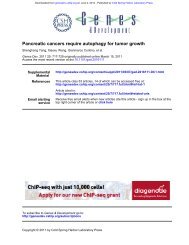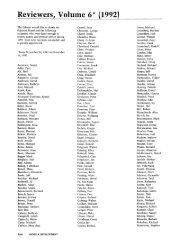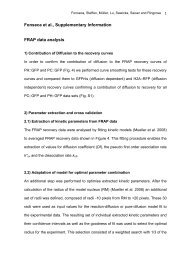I-Rel: a novel rei-related protein that inhibits NF-KB transcriptional ...
I-Rel: a novel rei-related protein that inhibits NF-KB transcriptional ...
I-Rel: a novel rei-related protein that inhibits NF-KB transcriptional ...
You also want an ePaper? Increase the reach of your titles
YUMPU automatically turns print PDFs into web optimized ePapers that Google loves.
Antibody:<br />
B<br />
Downloaded from<br />
genesdev.cshlp.org on December 18, 2012 - Published by Cold Spring Harbor Laboratory Press<br />
S^ xV!>^^ . .^^i -A^^^<br />
+ ++ + + + + +<br />
Antibody + + + +<br />
activity the following day. CAT activity in transfected<br />
cells <strong>that</strong> received the H<strong>KB</strong>-4CAT reporter alone was<br />
markedly induced after mitogenic stimulation, relative<br />
to the nonstimulated cells (Fig. IOC). In those cells receiving<br />
the CMV I-<strong>Rel</strong> vector, induction of CAT activity<br />
after mitogenic stimulation decreased as the amount of<br />
CMV I-<strong>Rel</strong> transfected was increased, with only slight<br />
induction evident when 3 |xg of CMV I-<strong>Rel</strong> was used.<br />
This is consistent with the cotransfection data demonstrating<br />
the ability of I-<strong>Rel</strong> to inhibit <strong>NF</strong>-<strong>KB</strong> function. As<br />
an indication of the specificity for inhibition, the ability<br />
of I-<strong>Rel</strong> expression to affect activation of the human immunodeficiency<br />
virus long terminal repeat (HIV LTR) by<br />
the trans-activator Tat (Rosen et al. 1985) was examined.<br />
No inhibition was observed upon cotransfection of CMV<br />
I-<strong>Rel</strong> with the HIV LTR CAT reporter in the presence of<br />
a Tat expression vector (Fig. lOD). Similarly, cotransfection<br />
of I-<strong>Rel</strong> with a Rous sarcoma virus (RSV) LTRdriven<br />
CAT reporter had only a minimal effect on CAT<br />
gene expression (not shown). These findings strongly<br />
L/I-<strong>Rel</strong>/HAI-<strong>Rel</strong><br />
HAp50<br />
— p50<br />
-I-<strong>Rel</strong>(A3)<br />
HAp65<br />
I-<strong>Rel</strong><br />
— HAp65(1-309)<br />
I-<strong>Rel</strong> <strong>inhibits</strong> <strong>NF</strong>-<strong>KB</strong> <strong>transcriptional</strong> activity<br />
Figure 7. Coimmunoprecipitation of I-<strong>Rel</strong><br />
with p50 and p65. The RNAs corresponding<br />
to the <strong>protein</strong> products shown were used to<br />
program rabbit reticulocyte lysates. The<br />
lanes depict translation reactions before immunoprecipitation<br />
( - ) or after immunoprecipitation<br />
with the anti-HA sera (+).<br />
suggest <strong>that</strong> expression of I-<strong>Rel</strong> selectively <strong>inhibits</strong> <strong>NF</strong>-<br />
<strong>KB</strong> activity in this system.<br />
Discussion<br />
We have identified a <strong>novel</strong> <strong>rei</strong>-<strong>related</strong> gene product designated<br />
I-<strong>Rel</strong> (for inhibitory <strong>rei</strong>) with properties quite dissimilar<br />
to re7-<strong>related</strong> <strong>protein</strong>s identified previously.<br />
I-<strong>Rel</strong>, as with other members of the lel family, contains<br />
a region of —300 amino acids <strong>that</strong> shares extensive identity<br />
with other <strong>rei</strong>-<strong>related</strong> <strong>protein</strong>s. The I-<strong>Rel</strong> cDNA,<br />
however, encodes an additional 120 amino acids at its<br />
amino terminus, and the divergent carboxy-terminal region<br />
is considerably shorter than other known <strong>rei</strong>-<strong>related</strong><br />
<strong>protein</strong>s. The most notable feature is the inability of<br />
I-<strong>Rel</strong> to bind the <strong>KB</strong> motif, in contrast to previously identified<br />
rel family members, each of which has been shown<br />
to associate with <strong>KB</strong> DNA (Ballard et al. 1990; Ghosh et<br />
al. 1990; Kieran et al. 1990; Ip et al. 1991; Nolan et al.<br />
GENES & DEVELOPMENT 753







